VUIS Consulting Project Plan: SAP S/4HANA Implementation and Testing
VerifiedAdded on 2020/04/07
|22
|2851
|351
Project
AI Summary
This project plan outlines the implementation of SAP S/4HANA for VUIS Consulting, detailing the project's scope, objectives, and deliverables. It covers the replacement of existing HR, accounting, and stock management systems with the new SAP system. The plan includes a comprehensive project schedule with milestones, a work breakdown structure, and a Gantt chart, along with resource allocation and budget estimates. Risk assessment and a communication plan are also provided to ensure effective project management. The project aims to integrate SAP business systems, organize staff training, and ultimately improve business operations and customer satisfaction. The plan considers factors such as data transfer, staff resistance, and system integration to ensure a smooth transition and successful implementation. Key components include server room modifications, data import, staff training, and project evaluation. The budget encompasses licensing, hardware, and personnel costs, while the risk assessment identifies potential challenges and mitigation strategies. The communication plan ensures stakeholders are informed of project progress and any required approvals.
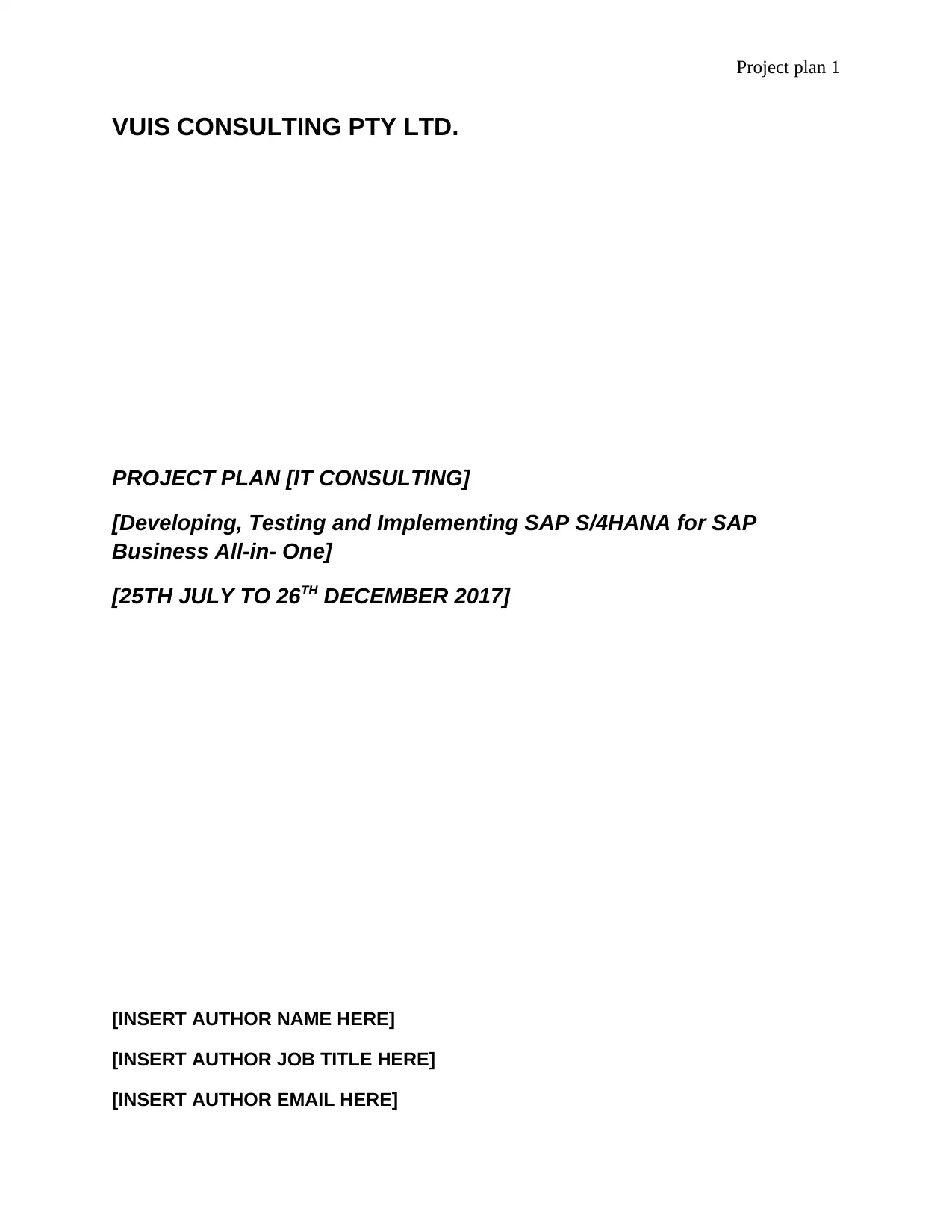
Project plan 1
VUIS CONSULTING PTY LTD.
PROJECT PLAN [IT CONSULTING]
[Developing, Testing and Implementing SAP S/4HANA for SAP
Business All-in- One]
[25TH JULY TO 26TH DECEMBER 2017]
[INSERT AUTHOR NAME HERE]
[INSERT AUTHOR JOB TITLE HERE]
[INSERT AUTHOR EMAIL HERE]
VUIS CONSULTING PTY LTD.
PROJECT PLAN [IT CONSULTING]
[Developing, Testing and Implementing SAP S/4HANA for SAP
Business All-in- One]
[25TH JULY TO 26TH DECEMBER 2017]
[INSERT AUTHOR NAME HERE]
[INSERT AUTHOR JOB TITLE HERE]
[INSERT AUTHOR EMAIL HERE]
Paraphrase This Document
Need a fresh take? Get an instant paraphrase of this document with our AI Paraphraser
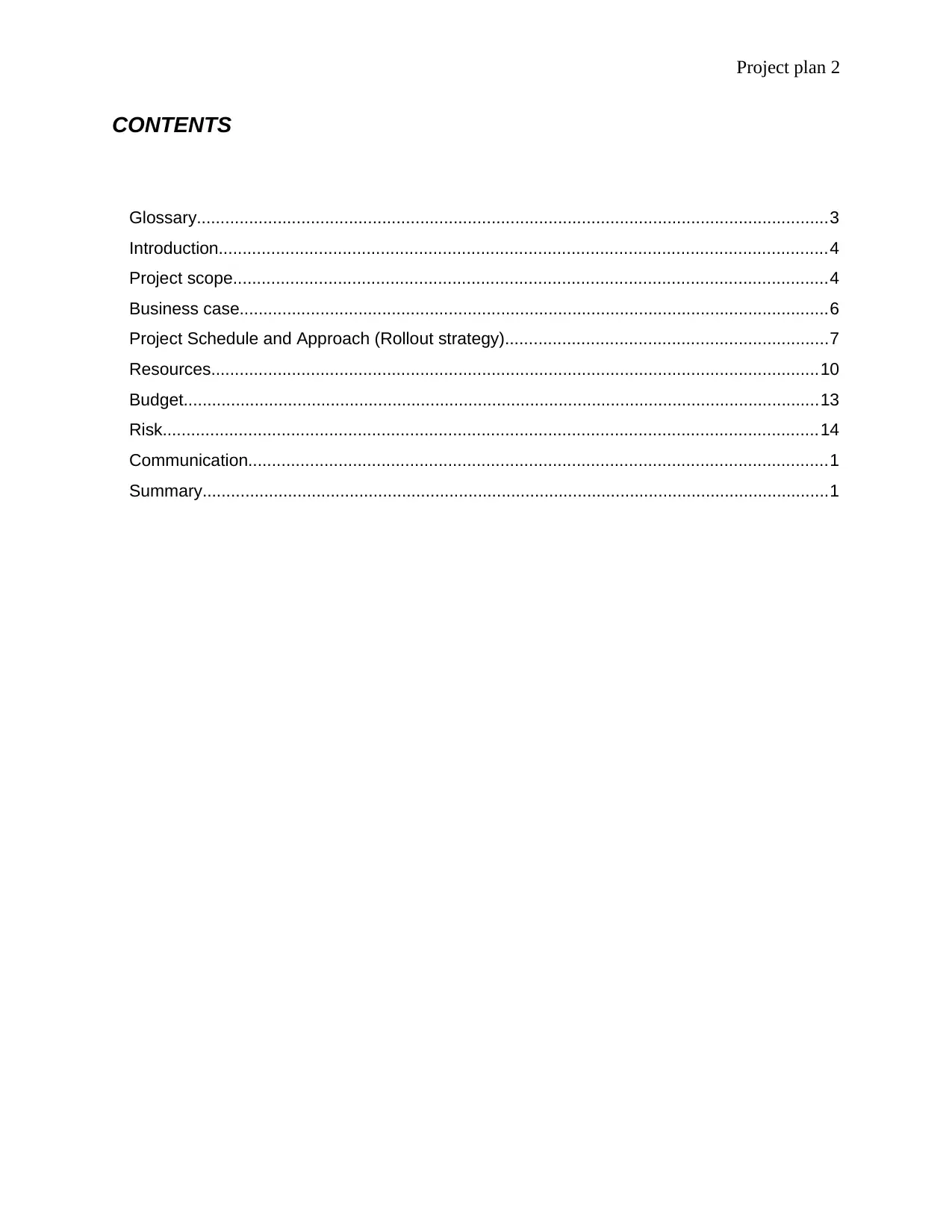
Project plan 2
CONTENTS
Glossary.....................................................................................................................................3
Introduction................................................................................................................................4
Project scope.............................................................................................................................4
Business case............................................................................................................................6
Project Schedule and Approach (Rollout strategy)....................................................................7
Resources................................................................................................................................10
Budget......................................................................................................................................13
Risk..........................................................................................................................................14
Communication..........................................................................................................................1
Summary....................................................................................................................................1
CONTENTS
Glossary.....................................................................................................................................3
Introduction................................................................................................................................4
Project scope.............................................................................................................................4
Business case............................................................................................................................6
Project Schedule and Approach (Rollout strategy)....................................................................7
Resources................................................................................................................................10
Budget......................................................................................................................................13
Risk..........................................................................................................................................14
Communication..........................................................................................................................1
Summary....................................................................................................................................1
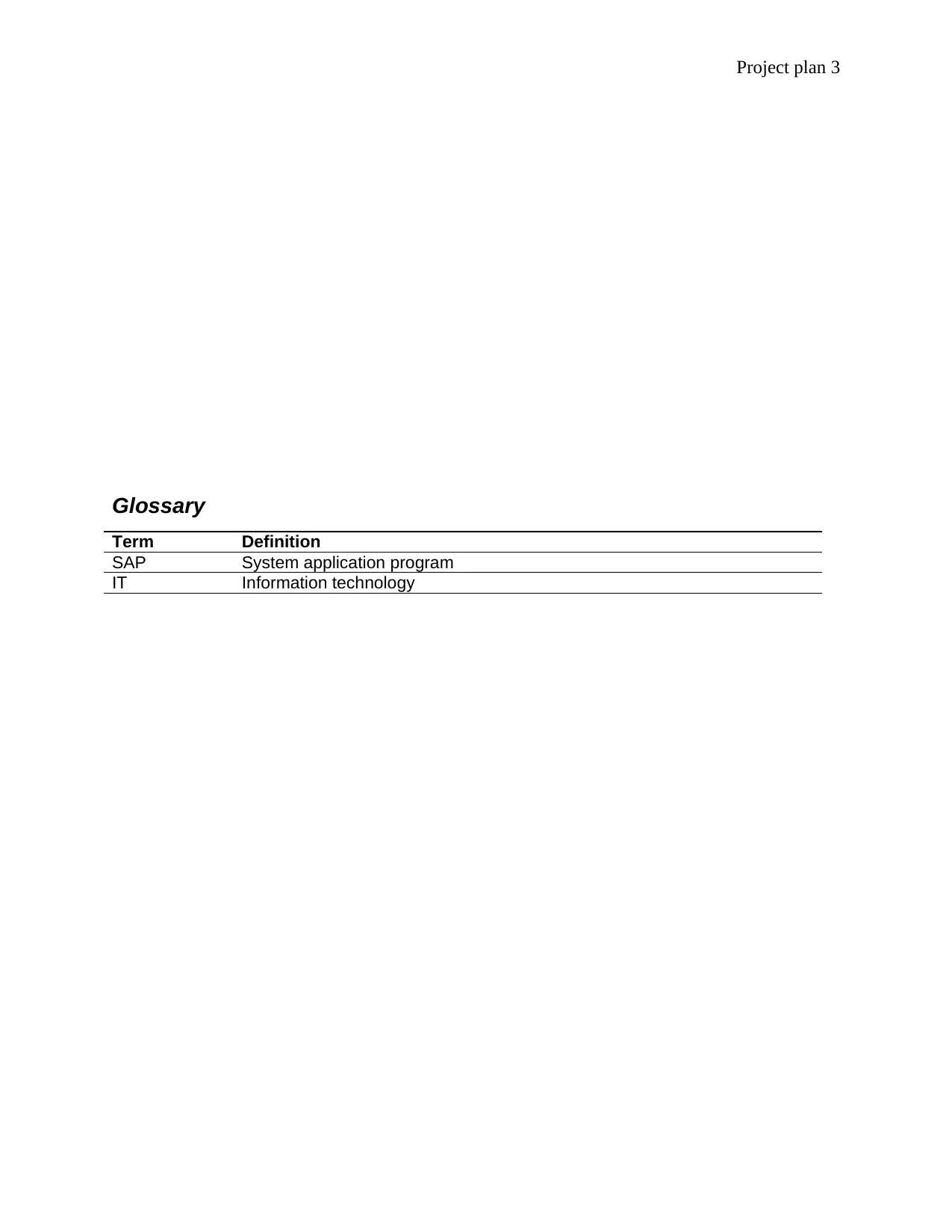
Project plan 3
Glossary
Term Definition
SAP System application program
IT Information technology
Glossary
Term Definition
SAP System application program
IT Information technology
⊘ This is a preview!⊘
Do you want full access?
Subscribe today to unlock all pages.

Trusted by 1+ million students worldwide
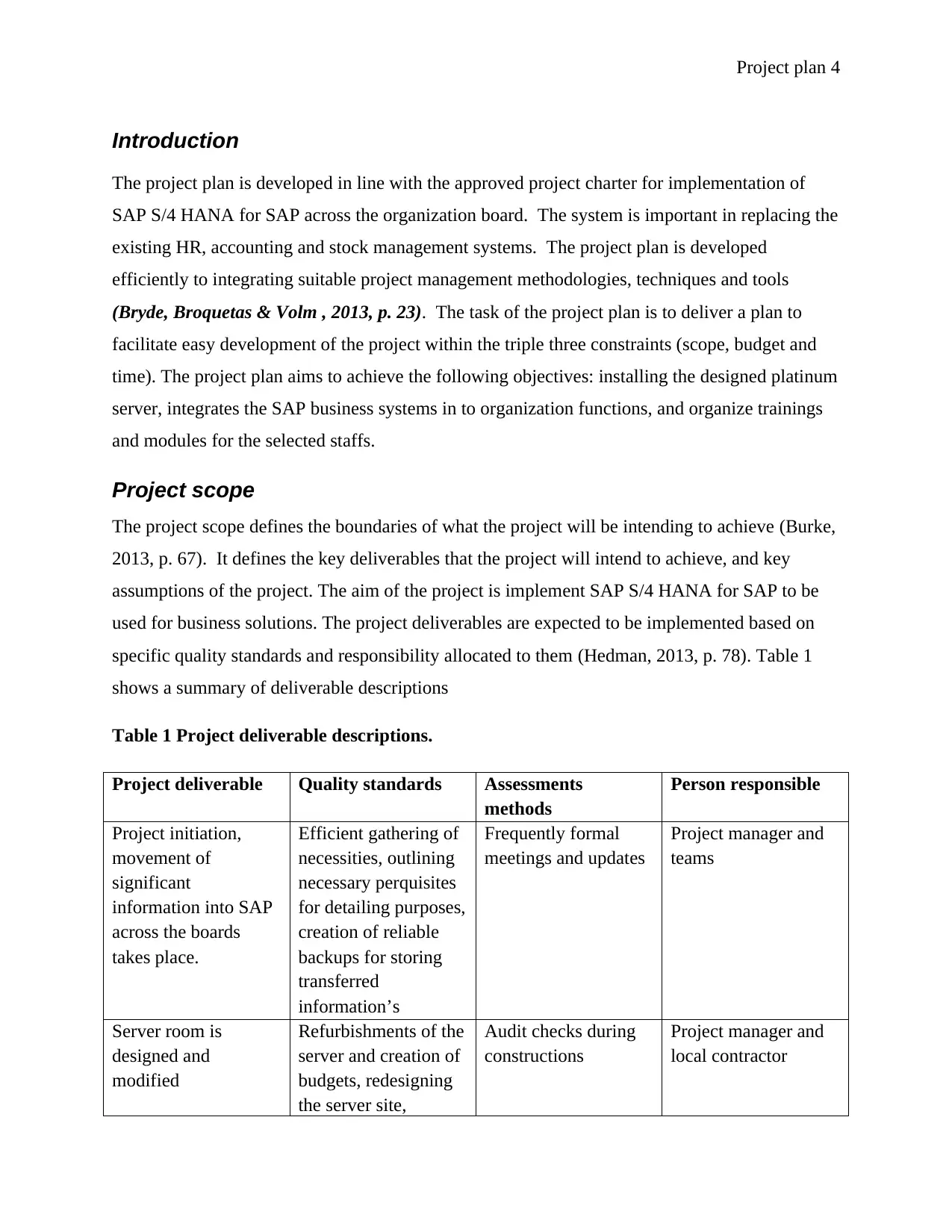
Project plan 4
Introduction
The project plan is developed in line with the approved project charter for implementation of
SAP S/4 HANA for SAP across the organization board. The system is important in replacing the
existing HR, accounting and stock management systems. The project plan is developed
efficiently to integrating suitable project management methodologies, techniques and tools
(Bryde, Broquetas & Volm , 2013, p. 23). The task of the project plan is to deliver a plan to
facilitate easy development of the project within the triple three constraints (scope, budget and
time). The project plan aims to achieve the following objectives: installing the designed platinum
server, integrates the SAP business systems in to organization functions, and organize trainings
and modules for the selected staffs.
Project scope
The project scope defines the boundaries of what the project will be intending to achieve (Burke,
2013, p. 67). It defines the key deliverables that the project will intend to achieve, and key
assumptions of the project. The aim of the project is implement SAP S/4 HANA for SAP to be
used for business solutions. The project deliverables are expected to be implemented based on
specific quality standards and responsibility allocated to them (Hedman, 2013, p. 78). Table 1
shows a summary of deliverable descriptions
Table 1 Project deliverable descriptions.
Project deliverable Quality standards Assessments
methods
Person responsible
Project initiation,
movement of
significant
information into SAP
across the boards
takes place.
Efficient gathering of
necessities, outlining
necessary perquisites
for detailing purposes,
creation of reliable
backups for storing
transferred
information’s
Frequently formal
meetings and updates
Project manager and
teams
Server room is
designed and
modified
Refurbishments of the
server and creation of
budgets, redesigning
the server site,
Audit checks during
constructions
Project manager and
local contractor
Introduction
The project plan is developed in line with the approved project charter for implementation of
SAP S/4 HANA for SAP across the organization board. The system is important in replacing the
existing HR, accounting and stock management systems. The project plan is developed
efficiently to integrating suitable project management methodologies, techniques and tools
(Bryde, Broquetas & Volm , 2013, p. 23). The task of the project plan is to deliver a plan to
facilitate easy development of the project within the triple three constraints (scope, budget and
time). The project plan aims to achieve the following objectives: installing the designed platinum
server, integrates the SAP business systems in to organization functions, and organize trainings
and modules for the selected staffs.
Project scope
The project scope defines the boundaries of what the project will be intending to achieve (Burke,
2013, p. 67). It defines the key deliverables that the project will intend to achieve, and key
assumptions of the project. The aim of the project is implement SAP S/4 HANA for SAP to be
used for business solutions. The project deliverables are expected to be implemented based on
specific quality standards and responsibility allocated to them (Hedman, 2013, p. 78). Table 1
shows a summary of deliverable descriptions
Table 1 Project deliverable descriptions.
Project deliverable Quality standards Assessments
methods
Person responsible
Project initiation,
movement of
significant
information into SAP
across the boards
takes place.
Efficient gathering of
necessities, outlining
necessary perquisites
for detailing purposes,
creation of reliable
backups for storing
transferred
information’s
Frequently formal
meetings and updates
Project manager and
teams
Server room is
designed and
modified
Refurbishments of the
server and creation of
budgets, redesigning
the server site,
Audit checks during
constructions
Project manager and
local contractor
Paraphrase This Document
Need a fresh take? Get an instant paraphrase of this document with our AI Paraphraser
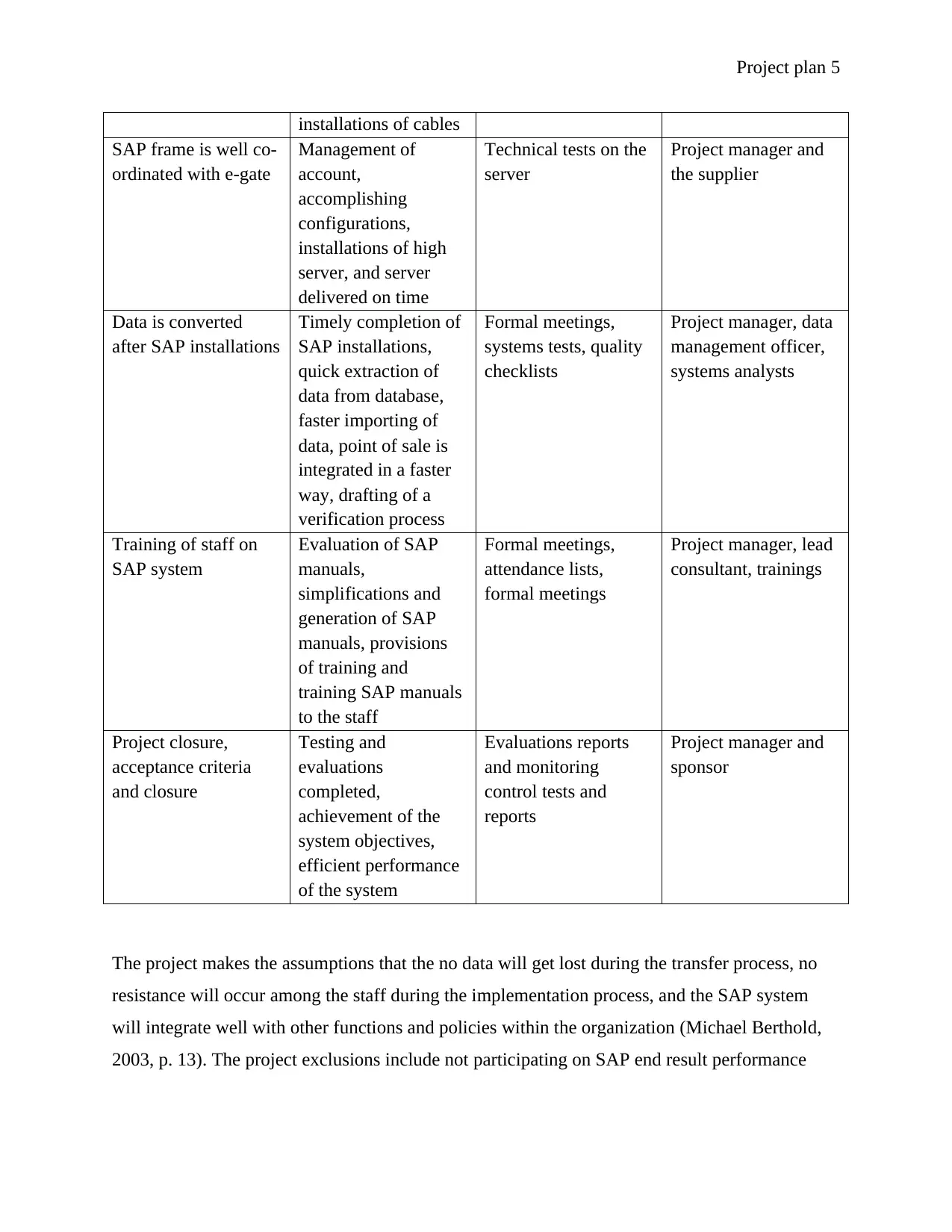
Project plan 5
installations of cables
SAP frame is well co-
ordinated with e-gate
Management of
account,
accomplishing
configurations,
installations of high
server, and server
delivered on time
Technical tests on the
server
Project manager and
the supplier
Data is converted
after SAP installations
Timely completion of
SAP installations,
quick extraction of
data from database,
faster importing of
data, point of sale is
integrated in a faster
way, drafting of a
verification process
Formal meetings,
systems tests, quality
checklists
Project manager, data
management officer,
systems analysts
Training of staff on
SAP system
Evaluation of SAP
manuals,
simplifications and
generation of SAP
manuals, provisions
of training and
training SAP manuals
to the staff
Formal meetings,
attendance lists,
formal meetings
Project manager, lead
consultant, trainings
Project closure,
acceptance criteria
and closure
Testing and
evaluations
completed,
achievement of the
system objectives,
efficient performance
of the system
Evaluations reports
and monitoring
control tests and
reports
Project manager and
sponsor
The project makes the assumptions that the no data will get lost during the transfer process, no
resistance will occur among the staff during the implementation process, and the SAP system
will integrate well with other functions and policies within the organization (Michael Berthold,
2003, p. 13). The project exclusions include not participating on SAP end result performance
installations of cables
SAP frame is well co-
ordinated with e-gate
Management of
account,
accomplishing
configurations,
installations of high
server, and server
delivered on time
Technical tests on the
server
Project manager and
the supplier
Data is converted
after SAP installations
Timely completion of
SAP installations,
quick extraction of
data from database,
faster importing of
data, point of sale is
integrated in a faster
way, drafting of a
verification process
Formal meetings,
systems tests, quality
checklists
Project manager, data
management officer,
systems analysts
Training of staff on
SAP system
Evaluation of SAP
manuals,
simplifications and
generation of SAP
manuals, provisions
of training and
training SAP manuals
to the staff
Formal meetings,
attendance lists,
formal meetings
Project manager, lead
consultant, trainings
Project closure,
acceptance criteria
and closure
Testing and
evaluations
completed,
achievement of the
system objectives,
efficient performance
of the system
Evaluations reports
and monitoring
control tests and
reports
Project manager and
sponsor
The project makes the assumptions that the no data will get lost during the transfer process, no
resistance will occur among the staff during the implementation process, and the SAP system
will integrate well with other functions and policies within the organization (Michael Berthold,
2003, p. 13). The project exclusions include not participating on SAP end result performance
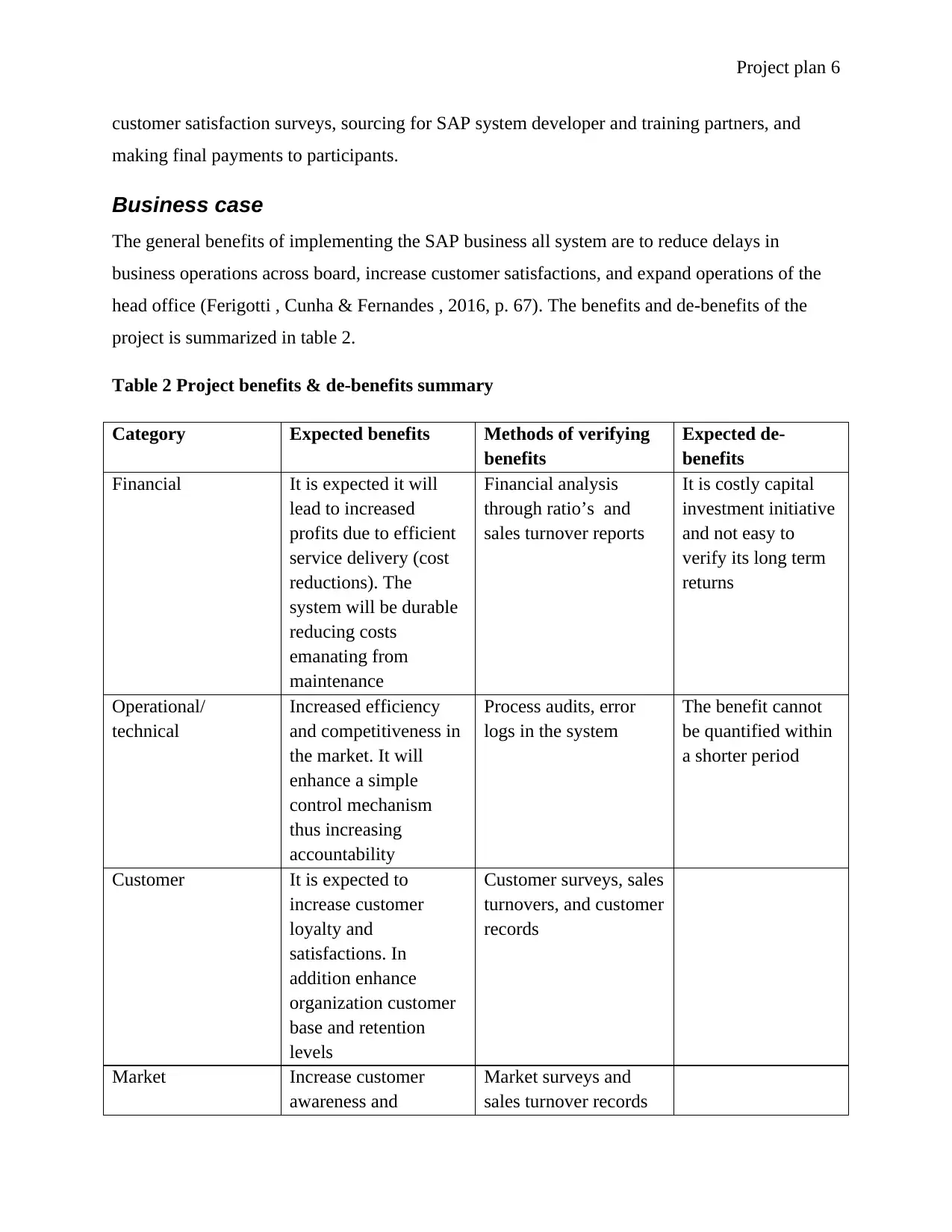
Project plan 6
customer satisfaction surveys, sourcing for SAP system developer and training partners, and
making final payments to participants.
Business case
The general benefits of implementing the SAP business all system are to reduce delays in
business operations across board, increase customer satisfactions, and expand operations of the
head office (Ferigotti , Cunha & Fernandes , 2016, p. 67). The benefits and de-benefits of the
project is summarized in table 2.
Table 2 Project benefits & de-benefits summary
Category Expected benefits Methods of verifying
benefits
Expected de-
benefits
Financial It is expected it will
lead to increased
profits due to efficient
service delivery (cost
reductions). The
system will be durable
reducing costs
emanating from
maintenance
Financial analysis
through ratio’s and
sales turnover reports
It is costly capital
investment initiative
and not easy to
verify its long term
returns
Operational/
technical
Increased efficiency
and competitiveness in
the market. It will
enhance a simple
control mechanism
thus increasing
accountability
Process audits, error
logs in the system
The benefit cannot
be quantified within
a shorter period
Customer It is expected to
increase customer
loyalty and
satisfactions. In
addition enhance
organization customer
base and retention
levels
Customer surveys, sales
turnovers, and customer
records
Market Increase customer
awareness and
Market surveys and
sales turnover records
customer satisfaction surveys, sourcing for SAP system developer and training partners, and
making final payments to participants.
Business case
The general benefits of implementing the SAP business all system are to reduce delays in
business operations across board, increase customer satisfactions, and expand operations of the
head office (Ferigotti , Cunha & Fernandes , 2016, p. 67). The benefits and de-benefits of the
project is summarized in table 2.
Table 2 Project benefits & de-benefits summary
Category Expected benefits Methods of verifying
benefits
Expected de-
benefits
Financial It is expected it will
lead to increased
profits due to efficient
service delivery (cost
reductions). The
system will be durable
reducing costs
emanating from
maintenance
Financial analysis
through ratio’s and
sales turnover reports
It is costly capital
investment initiative
and not easy to
verify its long term
returns
Operational/
technical
Increased efficiency
and competitiveness in
the market. It will
enhance a simple
control mechanism
thus increasing
accountability
Process audits, error
logs in the system
The benefit cannot
be quantified within
a shorter period
Customer It is expected to
increase customer
loyalty and
satisfactions. In
addition enhance
organization customer
base and retention
levels
Customer surveys, sales
turnovers, and customer
records
Market Increase customer
awareness and
Market surveys and
sales turnover records
⊘ This is a preview!⊘
Do you want full access?
Subscribe today to unlock all pages.

Trusted by 1+ million students worldwide
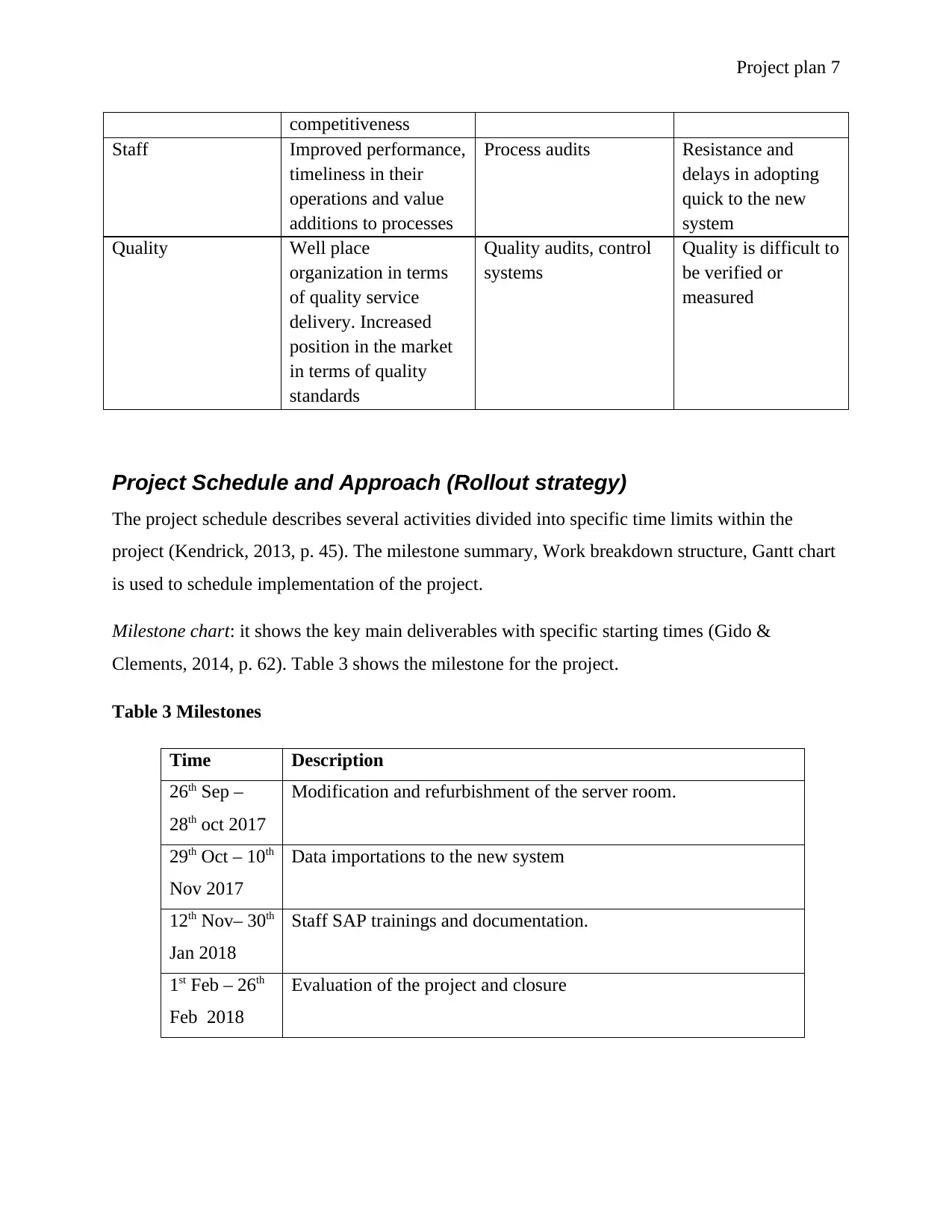
Project plan 7
competitiveness
Staff Improved performance,
timeliness in their
operations and value
additions to processes
Process audits Resistance and
delays in adopting
quick to the new
system
Quality Well place
organization in terms
of quality service
delivery. Increased
position in the market
in terms of quality
standards
Quality audits, control
systems
Quality is difficult to
be verified or
measured
Project Schedule and Approach (Rollout strategy)
The project schedule describes several activities divided into specific time limits within the
project (Kendrick, 2013, p. 45). The milestone summary, Work breakdown structure, Gantt chart
is used to schedule implementation of the project.
Milestone chart: it shows the key main deliverables with specific starting times (Gido &
Clements, 2014, p. 62). Table 3 shows the milestone for the project.
Table 3 Milestones
Time Description
26th Sep –
28th oct 2017
Modification and refurbishment of the server room.
29th Oct – 10th
Nov 2017
Data importations to the new system
12th Nov– 30th
Jan 2018
Staff SAP trainings and documentation.
1st Feb – 26th
Feb 2018
Evaluation of the project and closure
competitiveness
Staff Improved performance,
timeliness in their
operations and value
additions to processes
Process audits Resistance and
delays in adopting
quick to the new
system
Quality Well place
organization in terms
of quality service
delivery. Increased
position in the market
in terms of quality
standards
Quality audits, control
systems
Quality is difficult to
be verified or
measured
Project Schedule and Approach (Rollout strategy)
The project schedule describes several activities divided into specific time limits within the
project (Kendrick, 2013, p. 45). The milestone summary, Work breakdown structure, Gantt chart
is used to schedule implementation of the project.
Milestone chart: it shows the key main deliverables with specific starting times (Gido &
Clements, 2014, p. 62). Table 3 shows the milestone for the project.
Table 3 Milestones
Time Description
26th Sep –
28th oct 2017
Modification and refurbishment of the server room.
29th Oct – 10th
Nov 2017
Data importations to the new system
12th Nov– 30th
Jan 2018
Staff SAP trainings and documentation.
1st Feb – 26th
Feb 2018
Evaluation of the project and closure
Paraphrase This Document
Need a fresh take? Get an instant paraphrase of this document with our AI Paraphraser
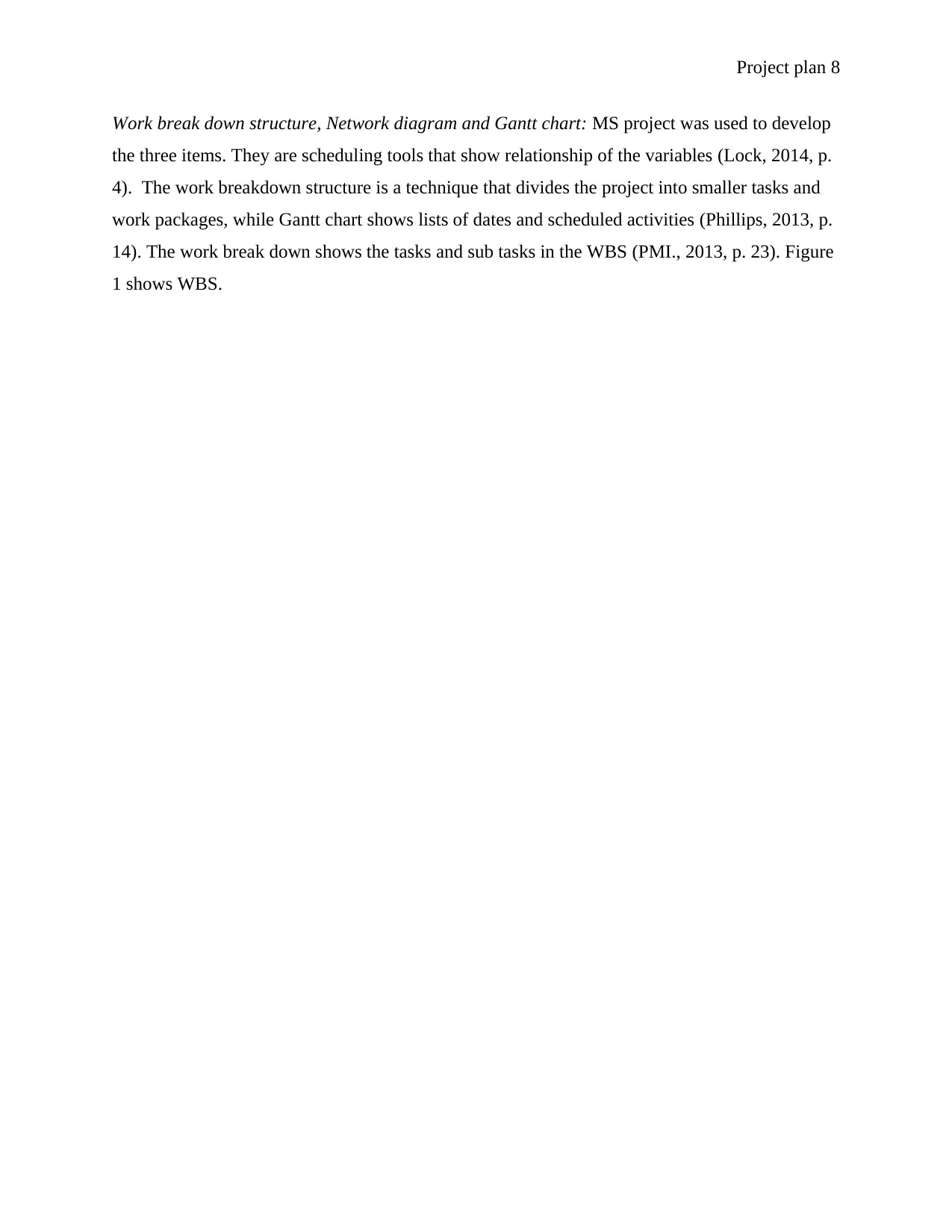
Project plan 8
Work break down structure, Network diagram and Gantt chart: MS project was used to develop
the three items. They are scheduling tools that show relationship of the variables (Lock, 2014, p.
4). The work breakdown structure is a technique that divides the project into smaller tasks and
work packages, while Gantt chart shows lists of dates and scheduled activities (Phillips, 2013, p.
14). The work break down shows the tasks and sub tasks in the WBS (PMI., 2013, p. 23). Figure
1 shows WBS.
Work break down structure, Network diagram and Gantt chart: MS project was used to develop
the three items. They are scheduling tools that show relationship of the variables (Lock, 2014, p.
4). The work breakdown structure is a technique that divides the project into smaller tasks and
work packages, while Gantt chart shows lists of dates and scheduled activities (Phillips, 2013, p.
14). The work break down shows the tasks and sub tasks in the WBS (PMI., 2013, p. 23). Figure
1 shows WBS.
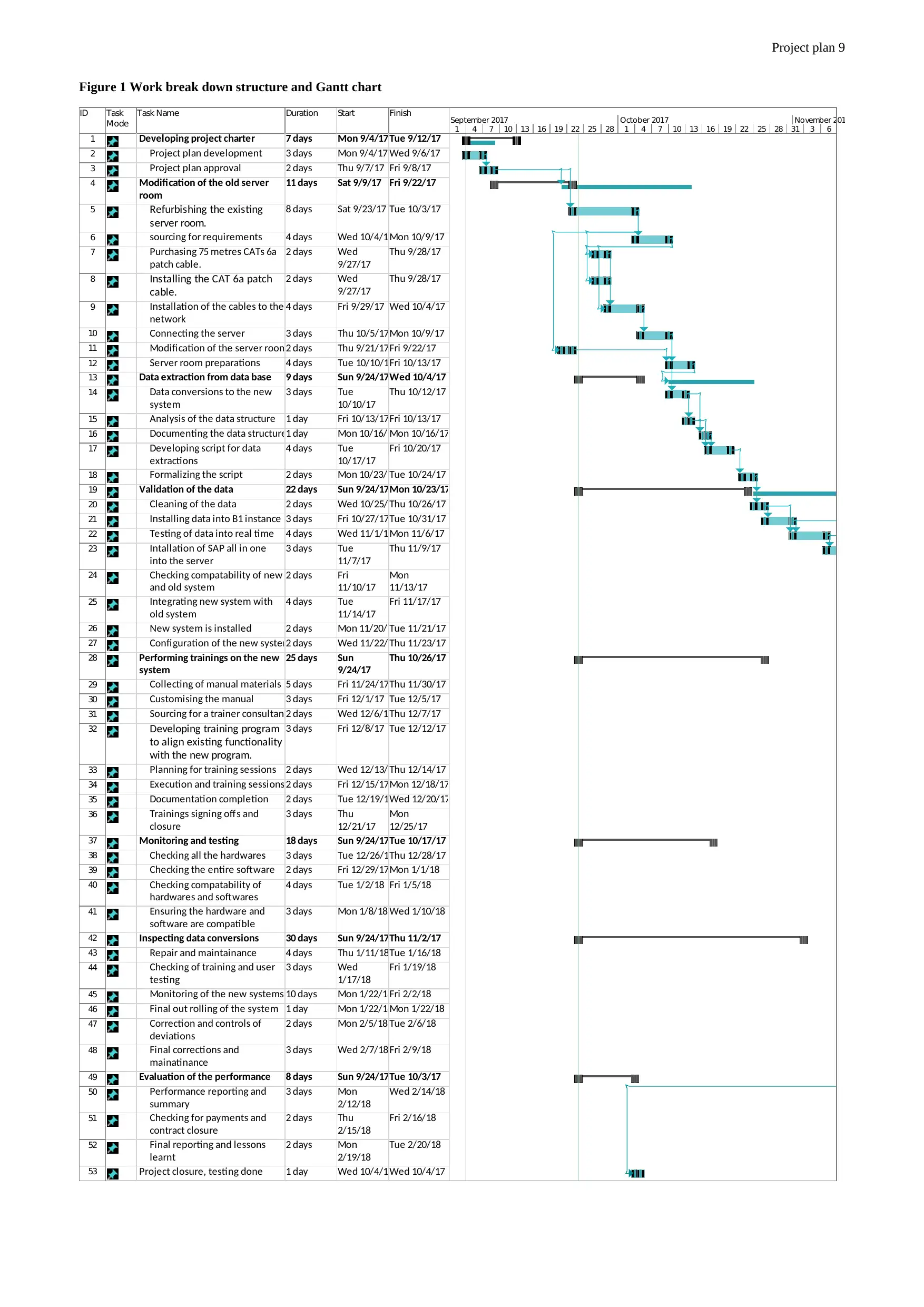
Project plan 9
Figure 1 Work break down structure and Gantt chart
ID Task
Mode
Task Name Duration Start Finish
1 Developing project charter 7 days Mon 9/4/17Tue 9/12/17
2 Project plan development 3 days Mon 9/4/17 Wed 9/6/17
3 Project plan approval 2 days Thu 9/7/17 Fri 9/8/17
4 Modification of the old server
room
11 days Sat 9/9/17 Fri 9/22/17
5 Refurbishing the existing
server room.
8 days Sat 9/23/17 Tue 10/3/17
6 sourcing for requirements 4 days Wed 10/4/17Mon 10/9/17
7 Purchasing 75 metres CATs 6a
patch cable.
2 days Wed
9/27/17
Thu 9/28/17
8 Installing the CAT 6a patch
cable.
2 days Wed
9/27/17
Thu 9/28/17
9 Installation of the cables to the
network
4 days Fri 9/29/17 Wed 10/4/17
10 Connecting the server 3 days Thu 10/5/17Mon 10/9/17
11 Modification of the server room2 days Thu 9/21/17Fri 9/22/17
12 Server room preparations 4 days Tue 10/10/17Fri 10/13/17
13 Data extraction from data base 9 days Sun 9/24/17Wed 10/4/17
14 Data conversions to the new
system
3 days Tue
10/10/17
Thu 10/12/17
15 Analysis of the data structure 1 day Fri 10/13/17Fri 10/13/17
16 Documenting the data structure1 day Mon 10/16/17Mon 10/16/17
17 Developing script for data
extractions
4 days Tue
10/17/17
Fri 10/20/17
18 Formalizing the script 2 days Mon 10/23/17Tue 10/24/17
19 Validation of the data 22 days Sun 9/24/17Mon 10/23/17
20 Cleaning of the data 2 days Wed 10/25/17Thu 10/26/17
21 Installing data into B1 instance 3 days Fri 10/27/17Tue 10/31/17
22 Testing of data into real time 4 days Wed 11/1/17Mon 11/6/17
23 Intallation of SAP all in one
into the server
3 days Tue
11/7/17
Thu 11/9/17
24 Checking compatability of new
and old system
2 days Fri
11/10/17
Mon
11/13/17
25 Integrating new system with
old system
4 days Tue
11/14/17
Fri 11/17/17
26 New system is installed 2 days Mon 11/20/17Tue 11/21/17
27 Configuration of the new system2 days Wed 11/22/17Thu 11/23/17
28 Performing trainings on the new
system
25 days Sun
9/24/17
Thu 10/26/17
29 Collecting of manual materials 5 days Fri 11/24/17Thu 11/30/17
30 Customising the manual 3 days Fri 12/1/17 Tue 12/5/17
31 Sourcing for a trainer consultant2 days Wed 12/6/17Thu 12/7/17
32 Developing training program
to align existing functionality
with the new program.
3 days Fri 12/8/17 Tue 12/12/17
33 Planning for training sessions 2 days Wed 12/13/17Thu 12/14/17
34 Execution and training sessions 2 days Fri 12/15/17Mon 12/18/17
35 Documentation completion 2 days Tue 12/19/17Wed 12/20/17
36 Trainings signing offs and
closure
3 days Thu
12/21/17
Mon
12/25/17
37 Monitoring and testing 18 days Sun 9/24/17Tue 10/17/17
38 Checking all the hardwares 3 days Tue 12/26/17Thu 12/28/17
39 Checking the entire software 2 days Fri 12/29/17Mon 1/1/18
40 Checking compatability of
hardwares and softwares
4 days Tue 1/2/18 Fri 1/5/18
41 Ensuring the hardware and
software are compatible
3 days Mon 1/8/18 Wed 1/10/18
42 Inspecting data conversions 30 days Sun 9/24/17Thu 11/2/17
43 Repair and maintainance 4 days Thu 1/11/18Tue 1/16/18
44 Checking of training and user
testing
3 days Wed
1/17/18
Fri 1/19/18
45 Monitoring of the new systems 10 days Mon 1/22/18Fri 2/2/18
46 Final out rolling of the system 1 day Mon 1/22/18Mon 1/22/18
47 Correction and controls of
deviations
2 days Mon 2/5/18 Tue 2/6/18
48 Final corrections and
mainatinance
3 days Wed 2/7/18Fri 2/9/18
49 Evaluation of the performance 8 days Sun 9/24/17Tue 10/3/17
50 Performance reporting and
summary
3 days Mon
2/12/18
Wed 2/14/18
51 Checking for payments and
contract closure
2 days Thu
2/15/18
Fri 2/16/18
52 Final reporting and lessons
learnt
2 days Mon
2/19/18
Tue 2/20/18
53 Project closure, testing done 1 day Wed 10/4/17Wed 10/4/17
1 4 7 10 13 16 19 22 25 28 1 4 7 10 13 16 19 22 25 28 31 3 6
September 2017 October 2017 November 2017
Figure 1 Work break down structure and Gantt chart
ID Task
Mode
Task Name Duration Start Finish
1 Developing project charter 7 days Mon 9/4/17Tue 9/12/17
2 Project plan development 3 days Mon 9/4/17 Wed 9/6/17
3 Project plan approval 2 days Thu 9/7/17 Fri 9/8/17
4 Modification of the old server
room
11 days Sat 9/9/17 Fri 9/22/17
5 Refurbishing the existing
server room.
8 days Sat 9/23/17 Tue 10/3/17
6 sourcing for requirements 4 days Wed 10/4/17Mon 10/9/17
7 Purchasing 75 metres CATs 6a
patch cable.
2 days Wed
9/27/17
Thu 9/28/17
8 Installing the CAT 6a patch
cable.
2 days Wed
9/27/17
Thu 9/28/17
9 Installation of the cables to the
network
4 days Fri 9/29/17 Wed 10/4/17
10 Connecting the server 3 days Thu 10/5/17Mon 10/9/17
11 Modification of the server room2 days Thu 9/21/17Fri 9/22/17
12 Server room preparations 4 days Tue 10/10/17Fri 10/13/17
13 Data extraction from data base 9 days Sun 9/24/17Wed 10/4/17
14 Data conversions to the new
system
3 days Tue
10/10/17
Thu 10/12/17
15 Analysis of the data structure 1 day Fri 10/13/17Fri 10/13/17
16 Documenting the data structure1 day Mon 10/16/17Mon 10/16/17
17 Developing script for data
extractions
4 days Tue
10/17/17
Fri 10/20/17
18 Formalizing the script 2 days Mon 10/23/17Tue 10/24/17
19 Validation of the data 22 days Sun 9/24/17Mon 10/23/17
20 Cleaning of the data 2 days Wed 10/25/17Thu 10/26/17
21 Installing data into B1 instance 3 days Fri 10/27/17Tue 10/31/17
22 Testing of data into real time 4 days Wed 11/1/17Mon 11/6/17
23 Intallation of SAP all in one
into the server
3 days Tue
11/7/17
Thu 11/9/17
24 Checking compatability of new
and old system
2 days Fri
11/10/17
Mon
11/13/17
25 Integrating new system with
old system
4 days Tue
11/14/17
Fri 11/17/17
26 New system is installed 2 days Mon 11/20/17Tue 11/21/17
27 Configuration of the new system2 days Wed 11/22/17Thu 11/23/17
28 Performing trainings on the new
system
25 days Sun
9/24/17
Thu 10/26/17
29 Collecting of manual materials 5 days Fri 11/24/17Thu 11/30/17
30 Customising the manual 3 days Fri 12/1/17 Tue 12/5/17
31 Sourcing for a trainer consultant2 days Wed 12/6/17Thu 12/7/17
32 Developing training program
to align existing functionality
with the new program.
3 days Fri 12/8/17 Tue 12/12/17
33 Planning for training sessions 2 days Wed 12/13/17Thu 12/14/17
34 Execution and training sessions 2 days Fri 12/15/17Mon 12/18/17
35 Documentation completion 2 days Tue 12/19/17Wed 12/20/17
36 Trainings signing offs and
closure
3 days Thu
12/21/17
Mon
12/25/17
37 Monitoring and testing 18 days Sun 9/24/17Tue 10/17/17
38 Checking all the hardwares 3 days Tue 12/26/17Thu 12/28/17
39 Checking the entire software 2 days Fri 12/29/17Mon 1/1/18
40 Checking compatability of
hardwares and softwares
4 days Tue 1/2/18 Fri 1/5/18
41 Ensuring the hardware and
software are compatible
3 days Mon 1/8/18 Wed 1/10/18
42 Inspecting data conversions 30 days Sun 9/24/17Thu 11/2/17
43 Repair and maintainance 4 days Thu 1/11/18Tue 1/16/18
44 Checking of training and user
testing
3 days Wed
1/17/18
Fri 1/19/18
45 Monitoring of the new systems 10 days Mon 1/22/18Fri 2/2/18
46 Final out rolling of the system 1 day Mon 1/22/18Mon 1/22/18
47 Correction and controls of
deviations
2 days Mon 2/5/18 Tue 2/6/18
48 Final corrections and
mainatinance
3 days Wed 2/7/18Fri 2/9/18
49 Evaluation of the performance 8 days Sun 9/24/17Tue 10/3/17
50 Performance reporting and
summary
3 days Mon
2/12/18
Wed 2/14/18
51 Checking for payments and
contract closure
2 days Thu
2/15/18
Fri 2/16/18
52 Final reporting and lessons
learnt
2 days Mon
2/19/18
Tue 2/20/18
53 Project closure, testing done 1 day Wed 10/4/17Wed 10/4/17
1 4 7 10 13 16 19 22 25 28 1 4 7 10 13 16 19 22 25 28 31 3 6
September 2017 October 2017 November 2017
⊘ This is a preview!⊘
Do you want full access?
Subscribe today to unlock all pages.

Trusted by 1+ million students worldwide
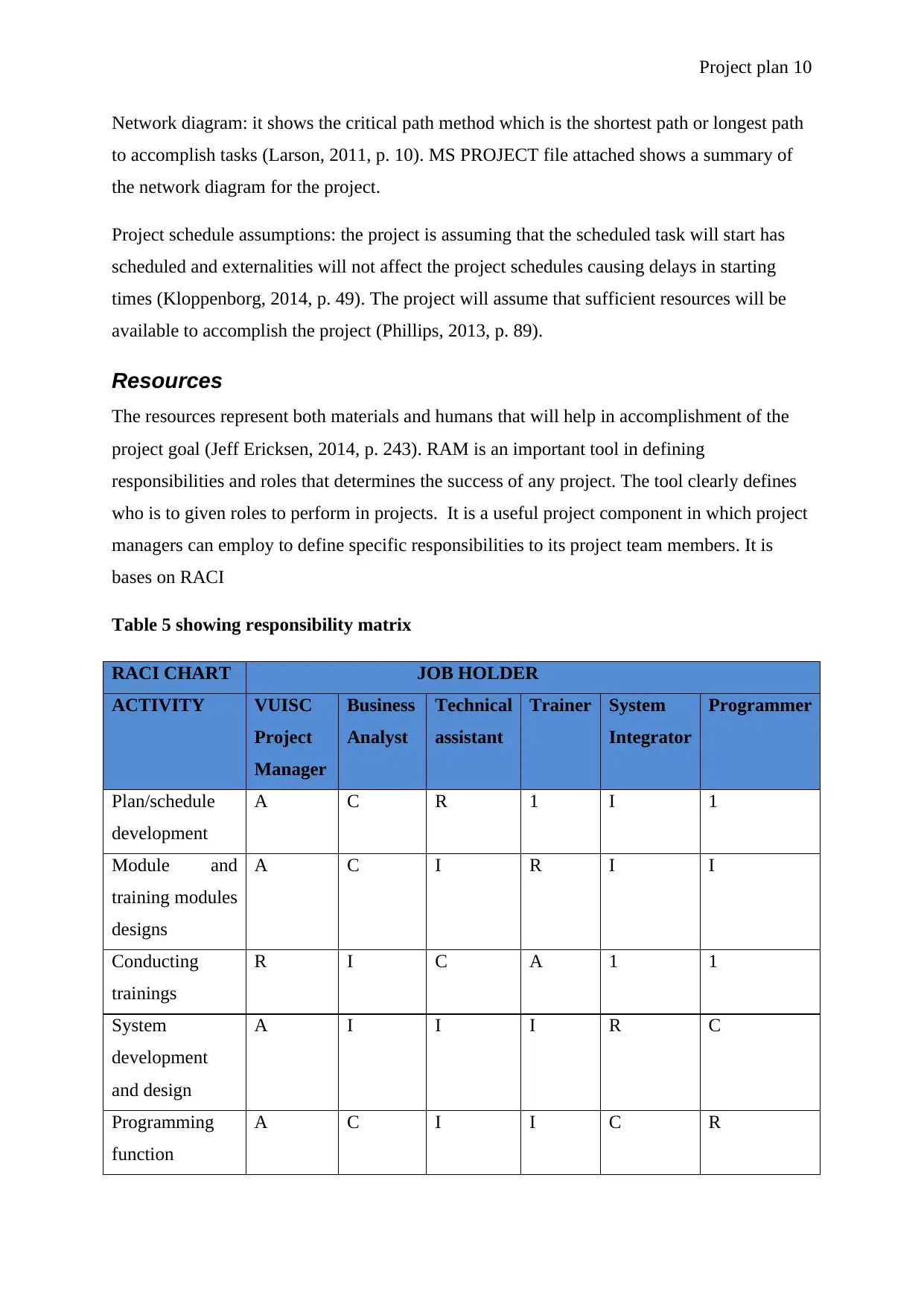
Project plan 10
Network diagram: it shows the critical path method which is the shortest path or longest path
to accomplish tasks (Larson, 2011, p. 10). MS PROJECT file attached shows a summary of
the network diagram for the project.
Project schedule assumptions: the project is assuming that the scheduled task will start has
scheduled and externalities will not affect the project schedules causing delays in starting
times (Kloppenborg, 2014, p. 49). The project will assume that sufficient resources will be
available to accomplish the project (Phillips, 2013, p. 89).
Resources
The resources represent both materials and humans that will help in accomplishment of the
project goal (Jeff Ericksen, 2014, p. 243). RAM is an important tool in defining
responsibilities and roles that determines the success of any project. The tool clearly defines
who is to given roles to perform in projects. It is a useful project component in which project
managers can employ to define specific responsibilities to its project team members. It is
bases on RACI
Table 5 showing responsibility matrix
RACI CHART JOB HOLDER
ACTIVITY VUISC
Project
Manager
Business
Analyst
Technical
assistant
Trainer System
Integrator
Programmer
Plan/schedule
development
A C R 1 I 1
Module and
training modules
designs
A C I R I I
Conducting
trainings
R I C A 1 1
System
development
and design
A I I I R C
Programming
function
A C I I C R
Network diagram: it shows the critical path method which is the shortest path or longest path
to accomplish tasks (Larson, 2011, p. 10). MS PROJECT file attached shows a summary of
the network diagram for the project.
Project schedule assumptions: the project is assuming that the scheduled task will start has
scheduled and externalities will not affect the project schedules causing delays in starting
times (Kloppenborg, 2014, p. 49). The project will assume that sufficient resources will be
available to accomplish the project (Phillips, 2013, p. 89).
Resources
The resources represent both materials and humans that will help in accomplishment of the
project goal (Jeff Ericksen, 2014, p. 243). RAM is an important tool in defining
responsibilities and roles that determines the success of any project. The tool clearly defines
who is to given roles to perform in projects. It is a useful project component in which project
managers can employ to define specific responsibilities to its project team members. It is
bases on RACI
Table 5 showing responsibility matrix
RACI CHART JOB HOLDER
ACTIVITY VUISC
Project
Manager
Business
Analyst
Technical
assistant
Trainer System
Integrator
Programmer
Plan/schedule
development
A C R 1 I 1
Module and
training modules
designs
A C I R I I
Conducting
trainings
R I C A 1 1
System
development
and design
A I I I R C
Programming
function
A C I I C R
Paraphrase This Document
Need a fresh take? Get an instant paraphrase of this document with our AI Paraphraser
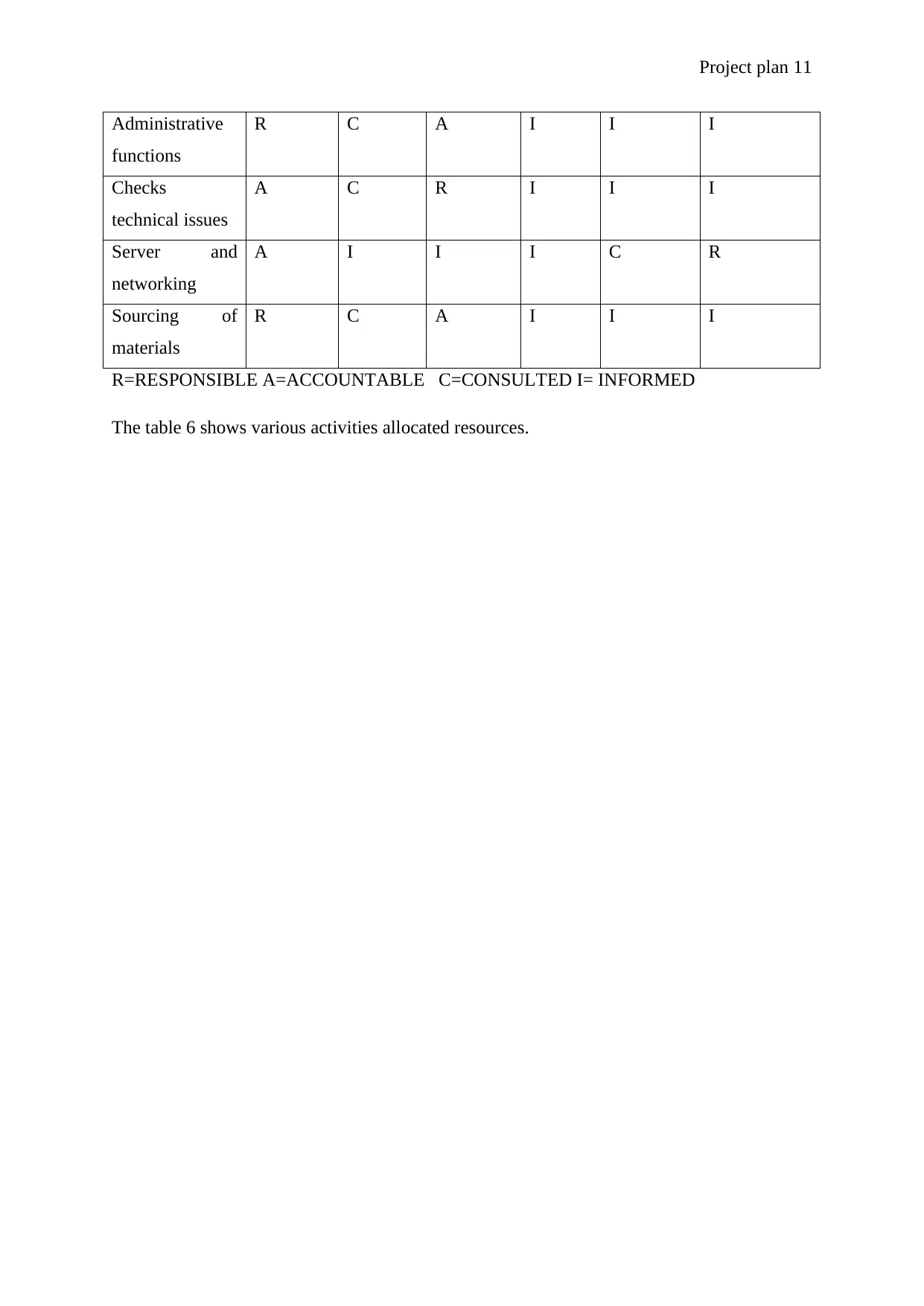
Project plan 11
Administrative
functions
R C A I I I
Checks
technical issues
A C R I I I
Server and
networking
A I I I C R
Sourcing of
materials
R C A I I I
R=RESPONSIBLE A=ACCOUNTABLE C=CONSULTED I= INFORMED
The table 6 shows various activities allocated resources.
Administrative
functions
R C A I I I
Checks
technical issues
A C R I I I
Server and
networking
A I I I C R
Sourcing of
materials
R C A I I I
R=RESPONSIBLE A=ACCOUNTABLE C=CONSULTED I= INFORMED
The table 6 shows various activities allocated resources.
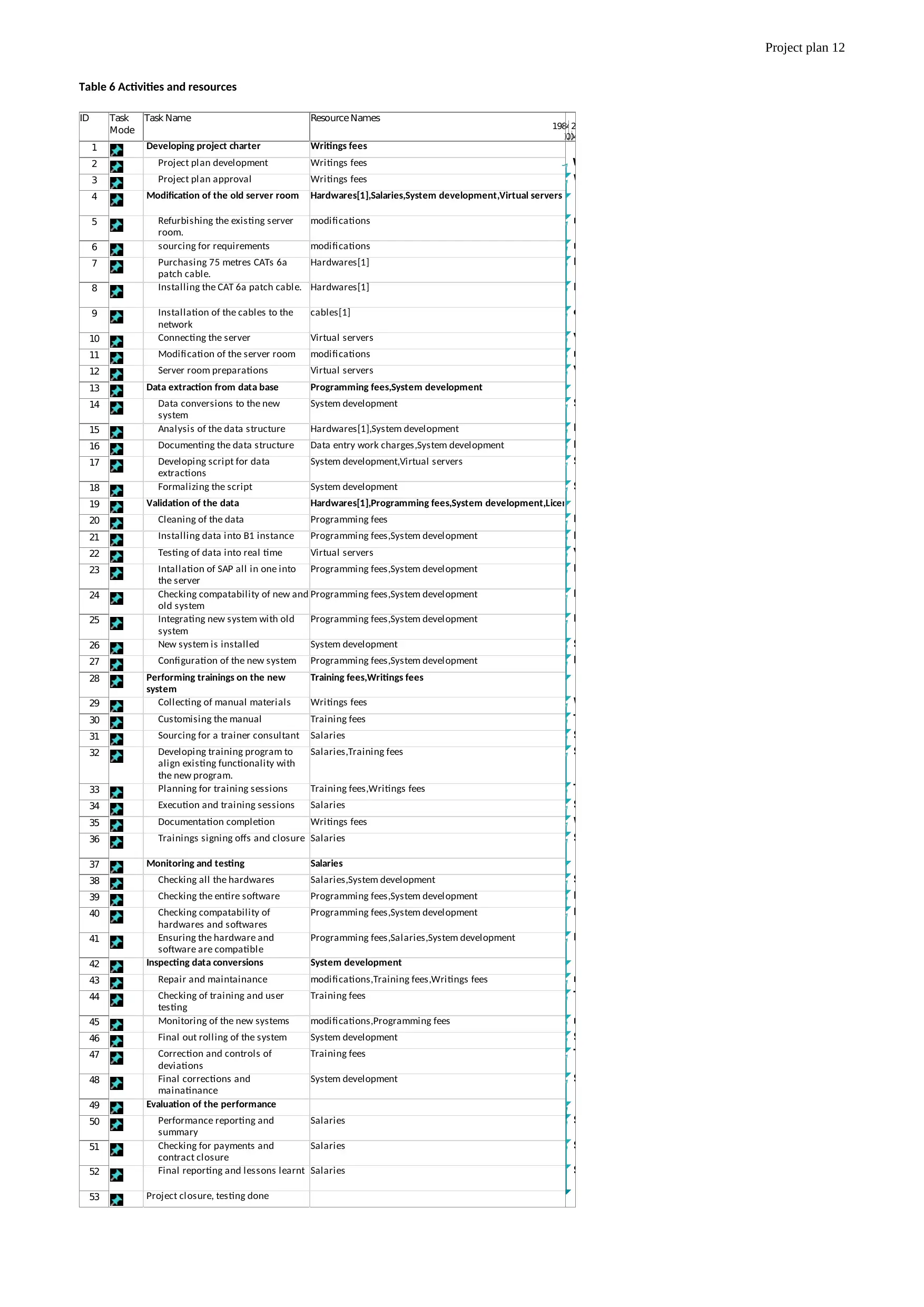
Project plan 12
Table 6 Activities and resources
ID Task
Mode
Task Name Resource Names
1 Developing project charter Writings fees
2 Project plan development Writings fees
3 Project plan approval Writings fees
4 Modification of the old server room Hardwares[1],Salaries,System development,Virtual servers
5 Refurbishing the existing server
room.
modifications
6 sourcing for requirements modifications
7 Purchasing 75 metres CATs 6a
patch cable.
Hardwares[1]
8 Installing the CAT 6a patch cable. Hardwares[1]
9 Installation of the cables to the
network
cables[1]
10 Connecting the server Virtual servers
11 Modification of the server room modifications
12 Server room preparations Virtual servers
13 Data extraction from data base Programming fees,System development
14 Data conversions to the new
system
System development
15 Analysis of the data structure Hardwares[1],System development
16 Documenting the data structure Data entry work charges,System development
17 Developing script for data
extractions
System development,Virtual servers
18 Formalizing the script System development
19 Validation of the data Hardwares[1],Programming fees,System development,Licensing
20 Cleaning of the data Programming fees
21 Installing data into B1 instance Programming fees,System development
22 Testing of data into real time Virtual servers
23 Intallation of SAP all in one into
the server
Programming fees,System development
24 Checking compatability of new and
old system
Programming fees,System development
25 Integrating new system with old
system
Programming fees,System development
26 New system is installed System development
27 Configuration of the new system Programming fees,System development
28 Performing trainings on the new
system
Training fees,Writings fees
29 Collecting of manual materials Writings fees
30 Customising the manual Training fees
31 Sourcing for a trainer consultant Salaries
32 Developing training program to
align existing functionality with
the new program.
Salaries,Training fees
33 Planning for training sessions Training fees,Writings fees
34 Execution and training sessions Salaries
35 Documentation completion Writings fees
36 Trainings signing offs and closure Salaries
37 Monitoring and testing Salaries
38 Checking all the hardwares Salaries,System development
39 Checking the entire software Programming fees,System development
40 Checking compatability of
hardwares and softwares
Programming fees,System development
41 Ensuring the hardware and
software are compatible
Programming fees,Salaries,System development
42 Inspecting data conversions System development
43 Repair and maintainance modifications,Training fees,Writings fees
44 Checking of training and user
testing
Training fees
45 Monitoring of the new systems modifications,Programming fees
46 Final out rolling of the system System development
47 Correction and controls of
deviations
Training fees
48 Final corrections and
mainatinance
System development
49 Evaluation of the performance
50 Performance reporting and
summary
Salaries
51 Checking for payments and
contract closure
Salaries
52 Final reporting and lessons learnt Salaries
53 Project closure, testing done
Writings fees
Writings fees
modifications
modifications
Hardwares[1]
Hardwares[1]
cables[1]
Virtual servers
modifications
Virtual servers
System development
Hardwares[1],System development
Data entry work charges,System development
System development,Virtual servers
System development
Programming fees
Programming fees,System development
Virtual servers
Programming fees,System development
Programming fees,System development
Programming fees,System development
System development
Programming fees,System development
Writings fees
Training fees
Salaries
Salaries,Training fees
Training fees,Writings fees
Salaries
Writings fees
Salaries
Salaries,System development
Programming fees,System development
Programming fees,System development
Programming fees,Salaries,System development
modifications,Training fees,Writings fees
Training fees
modifications,Programming fees
System development
Training fees
System development
Salaries
Salaries
Salaries
202420342044
19842034
Table 6 Activities and resources
ID Task
Mode
Task Name Resource Names
1 Developing project charter Writings fees
2 Project plan development Writings fees
3 Project plan approval Writings fees
4 Modification of the old server room Hardwares[1],Salaries,System development,Virtual servers
5 Refurbishing the existing server
room.
modifications
6 sourcing for requirements modifications
7 Purchasing 75 metres CATs 6a
patch cable.
Hardwares[1]
8 Installing the CAT 6a patch cable. Hardwares[1]
9 Installation of the cables to the
network
cables[1]
10 Connecting the server Virtual servers
11 Modification of the server room modifications
12 Server room preparations Virtual servers
13 Data extraction from data base Programming fees,System development
14 Data conversions to the new
system
System development
15 Analysis of the data structure Hardwares[1],System development
16 Documenting the data structure Data entry work charges,System development
17 Developing script for data
extractions
System development,Virtual servers
18 Formalizing the script System development
19 Validation of the data Hardwares[1],Programming fees,System development,Licensing
20 Cleaning of the data Programming fees
21 Installing data into B1 instance Programming fees,System development
22 Testing of data into real time Virtual servers
23 Intallation of SAP all in one into
the server
Programming fees,System development
24 Checking compatability of new and
old system
Programming fees,System development
25 Integrating new system with old
system
Programming fees,System development
26 New system is installed System development
27 Configuration of the new system Programming fees,System development
28 Performing trainings on the new
system
Training fees,Writings fees
29 Collecting of manual materials Writings fees
30 Customising the manual Training fees
31 Sourcing for a trainer consultant Salaries
32 Developing training program to
align existing functionality with
the new program.
Salaries,Training fees
33 Planning for training sessions Training fees,Writings fees
34 Execution and training sessions Salaries
35 Documentation completion Writings fees
36 Trainings signing offs and closure Salaries
37 Monitoring and testing Salaries
38 Checking all the hardwares Salaries,System development
39 Checking the entire software Programming fees,System development
40 Checking compatability of
hardwares and softwares
Programming fees,System development
41 Ensuring the hardware and
software are compatible
Programming fees,Salaries,System development
42 Inspecting data conversions System development
43 Repair and maintainance modifications,Training fees,Writings fees
44 Checking of training and user
testing
Training fees
45 Monitoring of the new systems modifications,Programming fees
46 Final out rolling of the system System development
47 Correction and controls of
deviations
Training fees
48 Final corrections and
mainatinance
System development
49 Evaluation of the performance
50 Performance reporting and
summary
Salaries
51 Checking for payments and
contract closure
Salaries
52 Final reporting and lessons learnt Salaries
53 Project closure, testing done
Writings fees
Writings fees
modifications
modifications
Hardwares[1]
Hardwares[1]
cables[1]
Virtual servers
modifications
Virtual servers
System development
Hardwares[1],System development
Data entry work charges,System development
System development,Virtual servers
System development
Programming fees
Programming fees,System development
Virtual servers
Programming fees,System development
Programming fees,System development
Programming fees,System development
System development
Programming fees,System development
Writings fees
Training fees
Salaries
Salaries,Training fees
Training fees,Writings fees
Salaries
Writings fees
Salaries
Salaries,System development
Programming fees,System development
Programming fees,System development
Programming fees,Salaries,System development
modifications,Training fees,Writings fees
Training fees
modifications,Programming fees
System development
Training fees
System development
Salaries
Salaries
Salaries
202420342044
19842034
⊘ This is a preview!⊘
Do you want full access?
Subscribe today to unlock all pages.

Trusted by 1+ million students worldwide
1 out of 22
Related Documents
Your All-in-One AI-Powered Toolkit for Academic Success.
+13062052269
info@desklib.com
Available 24*7 on WhatsApp / Email
![[object Object]](/_next/static/media/star-bottom.7253800d.svg)
Unlock your academic potential
Copyright © 2020–2025 A2Z Services. All Rights Reserved. Developed and managed by ZUCOL.




